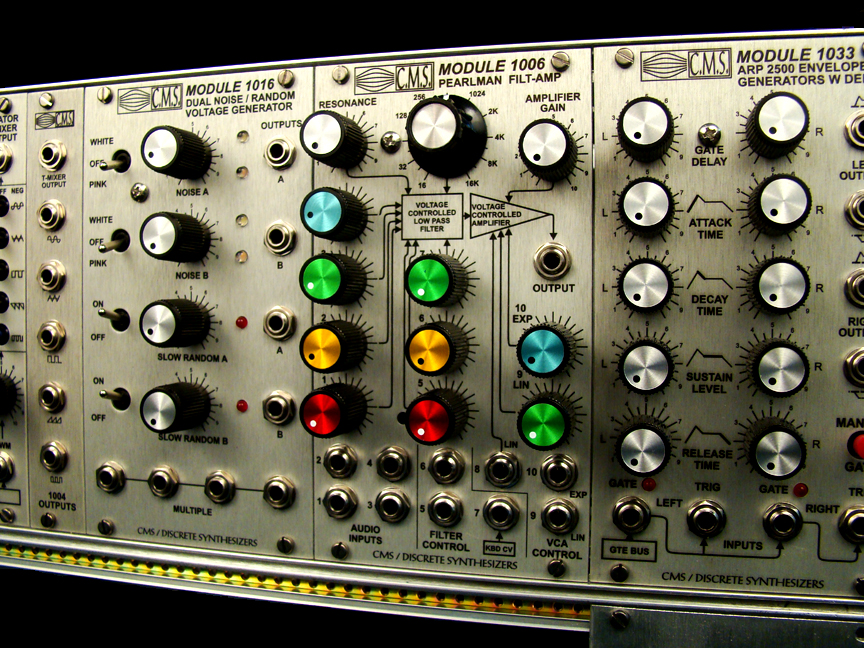| The CMS 1006 module is a top shelf
quality reproduction of the world famous ARP 1006 Filt-Amp
module in Euro-Rack form. The 1006 module was the basic building
block for the ARP 2500 synthesizer. CMS has made this critical
component used in the ARP 2500 available again in a high quality
version of the euro-rack format.
CMS Module 1006 is a functional
circuit package designed for use with the CMS Series 1000
electronic music synthesizer modules. This unit contains a
four-input audio mixer, a voltage controlled low-pass filter
(VCLPF) plus a voltage controlled amplifier with associated
circuitry.
The cutoff frequency of the filter
may be varied by external voltages or by the front panel fc
control. There are three separate filter control inputs at
the bottom of the module. The inputs are each associated with
an attenuator. With the attenuators rotated fully clockwise,
the sensitivity of these inputs is 1 volt/octave. Input #7
is pre-patched to the internal CV buss. This pre-patch can
be overridden by inserting a jack into input #7. The voltages
appearing at each control input are summed internally and
the cutoff frequency of the filter will be determined by this
sum. Although the sum of all the control inputs may exceed
the effective input range of the filter, (i.e., +10v) no damage
can be done to the circuitry by such overdrive.
A resonance or "peaked"
response at the cutoff frequency may be obtained if so desired.
This is useful for creating certain types of formants, such
as "wa-wa" or "yeow" effect. A knob control
permits adjustment of the height of the resonant peak.
Up to four audio signal inputs to the filter may be mixed
and their relative amplitudes adjusted by means of four panel
knobs.
The voltage controlled amplifier
(VCA) accepts the output signal from the voltage controlled
filter (VCF) and modifies the signal level according to the
sum of a local control voltage (supplied by a panel knob control)
and a number of external control voltage signals.
The voltage controlled amplifier may be operated in two modes
simultaneously, unlike the origianl ARP module. The exponential
input has a control transfer function of 10 dB per volt. The
linear inputs have a control function of Vout = VcsVin referred
to a 400 Hz sine audio input signal applied to one of the
Filt-Amp audio input terminals with the corresponding audio
control knob in the extreme clock-wise position, the filter
in the wide band condition (sum of control voltages = +10v)
with the filter cutoff frequency knob in the extreme clockwise
position and the resonance control knob in the extreme counter-clockwise
position.
The range of the voltage controlled
amplifier is over 100 dB, which permits the VCA to be used
as a squelch gate control device. By proper adjustment of
controls no discernible output should be obtained in the absence
of control voltages, even when the audio inputs are operated
at maximum levels.
CMS has decades of extensive
knowledge and experience building, testing and repairing many
different incarnations of the Moog transistor ladder filter.
We have taken this expertise and applied it to the euro-rack
world.
The 1006 filter section is ARP's
version of the transistor ladder filter. It differs from the
4012 ladder filter used in early 2600s because it uses a purely
bipolar transistor signal path. It has a warmer sound and
a different frequency response than the ARP 2600 filter. The
resonance on this filter sounds different than the 2600 filter
also.
Using the 1006 low-pass response
in series with the 1047 high-pass function enables the user
to accurately reproduce many of the classic ARP 2500 sounds.
You can now realize this sound in your studio with the 1047
and 1006 from CMS.
If you want to reproduce the
sound of the ARP 2500 exactly, check out our other 1000 series
modules available from CMS. They are all based on the ARP
2500 system.
FEATURES:
This complex circuit utilizes
an all-bipolar matched transistor signal path to produce it's
distinctive and highly resonant sound.
High quality construction and
top shelf components, Switchcraft jacks, Alps attenuators.
CMS engineering used in many
professional recording studios across the USA and Europe.
Main frequency control pot features
an extra large geometry "virtual infinite resolution"
potentiometer for accurate control of frequency.
The VCF has 3 control voltage
inputs with attenuators fixed at 1v per octave.
The VCA has 3 control voltage
inputs. 2 linear control inputs: one fixed and one with an
attenuator. 1 attenuated exponential control input
Easy to understand flowchart
front panel graphics facilitate operation.
The new improved front panel
is now made of a special material that has the image impregnated
into the aluminum surface. It will not fade over time or wear
off from finger action.
| 
